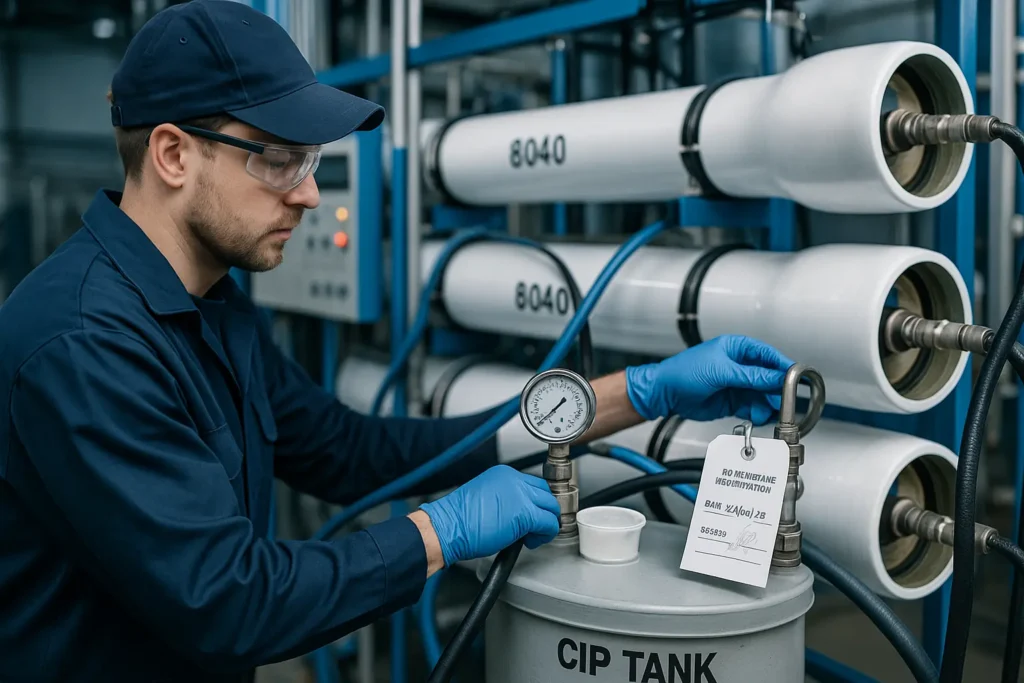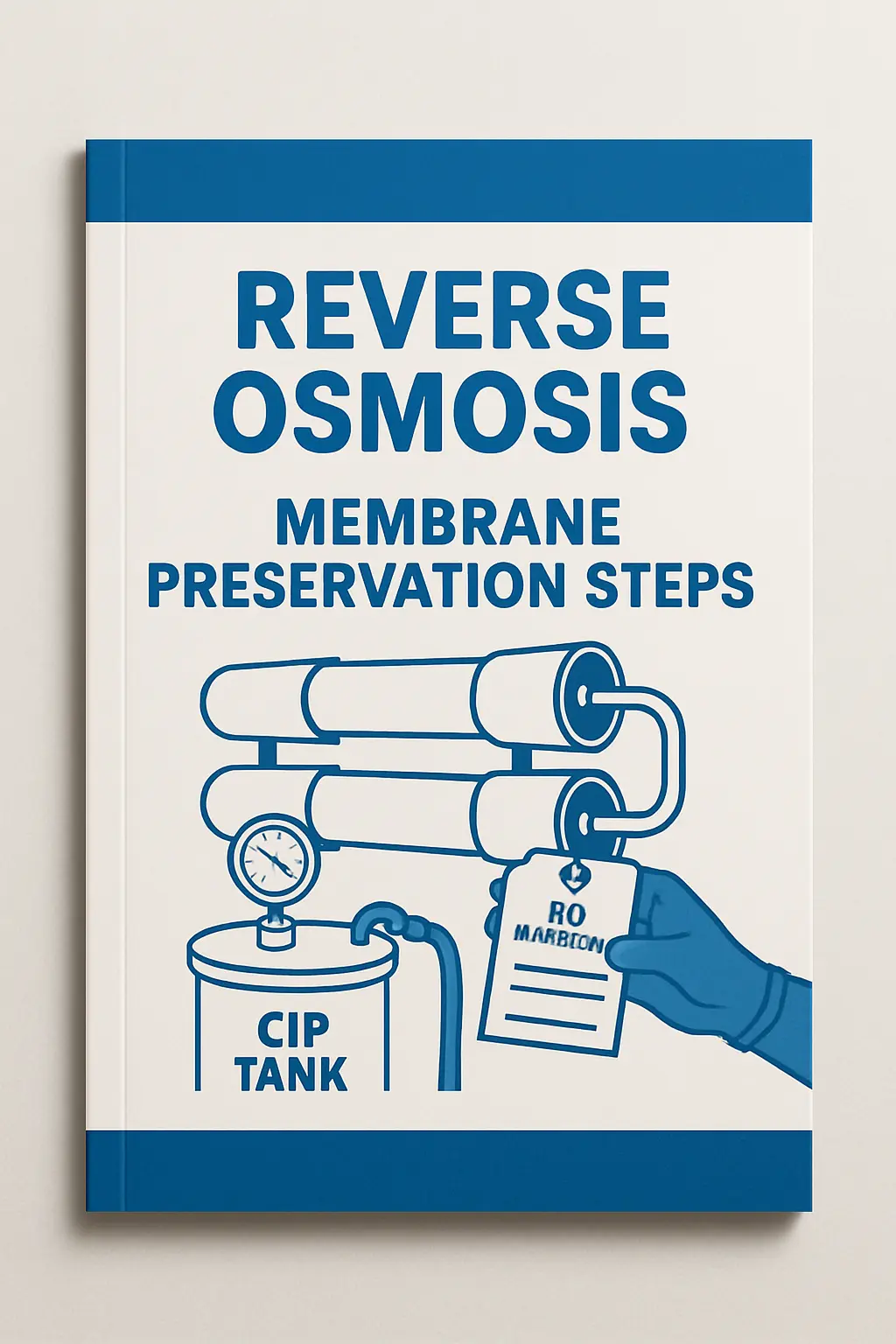ro membrane preservation prevents biofouling and oxidation during shutdowns, shipping, or seasonal operation. This guide explains when to preserve, the correct solutions and temperatures, how to restart safely, and how to verify performance for 1812/4040/8040 systems.
This guide helps you plan ro membrane preservation for short, medium, and long shutdowns.
See RO Membrane Cleaning Replacement Checklist
When to Preserve an RO System
- Short-term: anticipated outage > 24–48 hours (weekend/holiday, maintenance).
- Medium-term: 1–8 weeks (seasonal reduction, plant standby).
- Long-term: > 2 months (lay-up, project pause, spare trains in storage).
For short breaks, a biostatic alkaline hold may be enough. For longer periods, perform a cleaning, drain, and recirculate a preservation solution that remains effective and compatible with your membrane model.

Preservation Solutions and Compatibility
| Use case | Typical chemistry | Notes |
|---|---|---|
| Short-term biostatic hold | Alkaline solution with biodegradable surfactant (manufacturer-approved) | Inhibits microbial growth; circulate and soak; avoid oxidants on TFC membranes. |
| Long-term lay-up | Manufacturer-approved preservative (e.g., sodium metabisulfite blends or proprietary biocide) | Observe pH and temperature limits; fully displace feed; label vessels with date/chemistry. |
| Element in sealed bag | Factory preservative (often sodium metabisulfite) | Keep the bag sealed until installation; store at 5–30 °C away from sunlight and heat sources. |
Always follow the element datasheet and safety data sheet. Do not use free chlorine with thin-film composite (TFC) membranes unless specifically allowed by the supplier.
Document chemistry, time, and temperature for every ro membrane preservation event and keep a log on the vessel.
ro membrane preservation — step-by-step procedure
- Clean and inspect. If fouling is present, perform an alkaline or acid CIP as appropriate. Inspect end-cap O-rings and interconnectors.
- Drain and isolate. Stop production, relieve pressure, and isolate the train. Bypass downstream tanks to remove backpressure.
- Mix solution. Prepare the approved preservation solution with permeate or demineralized water. Verify pH and temperature limits for your model.
- Recirculate. Fill and recirculate through all vessels at low flow to fully displace feed water. Vent air. Soak for the recommended time.
- Tag and record. Label each train with date, chemistry, concentration, and temperature. Log readings and valve positions.
- Maintain. For long lay-ups, periodically recirculate or refresh the solution per supplier guidance.
ro membrane preservation — storage limits and temperature
Keep sealed elements between 5 and 30 °C. Avoid freezing and direct sunlight; re-preserve if a bag is opened or preservative is expired.
Storage of Spare Elements (1812/4040/8040)
- Keep elements in original sealed bags with factory preservative until use.
- Store cartons horizontally on clean racks; avoid stacking that could deform end caps.
- Temperature 5–30 °C; avoid freezing and direct sunlight. Keep away from oxidants and vapors.
- Rotate stock (FIFO) and re-preserve if the bag is opened or if the preservative has expired.
Restart After Preservation
- Safety first. Verify correct valve alignment; ensure concentrate is open and permeate is diverted to drain.
- Flush. Rinse preservative with permeate until pH and smell are normal; follow local discharge rules.
- Ramp-up. Pressurize slowly, check for leaks, and avoid permeate production until stable.
- QA. Record normalized permeate flow, salt rejection, and differential pressure as the new baseline.
If performance does not recover, follow the RO membrane troubleshooting flow and, if needed, the cleaning guide.
If performance does not recover after restart, repeat the ro membrane preservation flush and verify normalization before diagnosing.
Common Preservation Pitfalls
- Leaving residual chlorine or chloramine in the system before lay-up.
- Not fully displacing feed water, allowing microbial growth in dead legs or housings.
- Using incompatible biocides or wrong pH, attacking the TFC layer or elastomers.
- Restarting directly to service without draining to waste and normalizing readings.
References
DuPont FilmTec RO/NF Technical Manual | AMTA Fact Sheet — Cleaning in Place (CIP)
Need a Preservation Kit?
Tell us your train size, element count, and shutdown length. We will recommend compatible preservative, mixing ratios, and a refresh schedule, plus labels and a log sheet.

